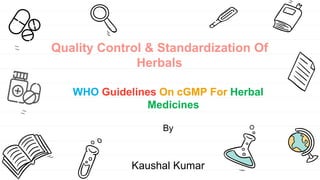
WHO guideline on cGMP.pptx
- 1. Quality Control & Standardization Of Herbals WHO Guidelines On cGMP For Herbal Medicines By Kaushal Kumar
- 2. TABLE OF CONTENTS 01 02 03 04 Introduction WHO Guidelines General Requirements Explanation
- 3. WHO to provide technical support to develop a methodology to monitor or ensure the quality, efficacy and safety of traditional medicine and its products. To promote and improve the quality of herbal medicines and also to reduce the proportion of adverse effect caused by the poor quality of herbal medicines. The manufacturing process is one of the key steps where, quality control is required to ensure quality of medicinal products including herbal medicines. cGMP is one of the most important tools for this measure. INTRODUCTION
- 4. → Quality assurance in the manufacture of herbal medicines → Sanitation and hygiene → Qualification & Validation → Complaints → Product Recalls → Contract Production & Analysis → Self-Inspection → Personnel → Training → Personal Hygiene → Premises → Storage areas → Production Areas → Equipment's → Material → Documentations → Good Practice in Productions → Good Practice in Quality Practice WHO Guidelines On cGMP
- 5. → Quality assurance in the manufacture of herbal medicines The use of modern analytical techniques especially HPTLC, GC, HPLC, CE, MS And AA are used to characterize herbal medicines. Quality assurance also requires the control of starting materials, storage and processing. For this reason, an appropriate quality assurance system should be applied in the manufacture of herbal medicines. → Sanitation and hygiene To avoid alterations and reduce contamination, a high level of sanitation and hygiene is necessary during the manufacturing process. Water supply to the manufacturing unit should be monitored and if necessary, treated appropriately to ensure consistency of quality. Waste bins should be available, emptied, and cleaned at least daily. WHO Guidelines On cGMP
- 6. → Qualification & Validation The written procedure should specify process steps and factors (such as extraction time, temperature and solvent purity), acceptance criteria and the type of validation to be conducted and the number of process runs. → Complaints Product quality complaints may be caused by problems such as faulty manufacture, product defects or deterioration of herbal medicines and adulteration of the herbal material. These complaints should be recorded in detail and their causes by comparing with the reference samples kept from the same batch. WHO Guidelines On cGMP
- 7. → Product Recalls There should be a standard operating procedure (SOP) for the storage of recalled herbal medicines in a secure isolated area, complying with the requirements specified. → Contract Production & Analysis Contract should be drawn up by experienced people suitably knowledgeable on the specific characteristics of herbal medicines including their production and quality control testing. → Self-Inspection One member of the self-inspection should have a through knowledge of herbal medicines. WHO Guidelines On cGMP
- 8. → Personnel All responsible staff should have their duties recorded in written descriptions and adequate authority to carry out their responsibilities. Their duties may be given to designated deputies of a satisfactory qualification level. → Training The personnel should have adequate training in appropriate fields such as pharmaceutical technology, taxonomic botany, phytochemistry, pharmacognosy, hygiene, microbiology and related subjects. → Personal Hygiene Personnel must be protected from contact with toxic irritants and allergenic plant materials using suitable protective clothing. They should wear suitable gloves, caps, masks, work suits and shoes throughout the whole procedure from plant processing to product manufacture. WHO Guidelines On cGMP
- 9. → Premises The premises should be designed, located, constructed, adapted and maintained to suit the operations to be carried out according to WHO guidelines. → Storage areas The areas should be well labelled and materials stored in such a way as to avoid any risk of cross-contamination. An area should be identified for the quarantine of all incoming herbal materials. Different herbal materials should be stored in separate areas. → Production Areas To facilitate cleaning and to avoid cross contamination, adequate precautions should be taken during the sampling, weighing, mixing and processing of medicinal plants. WHO Guidelines On cGMP
- 10. → Equipment’s Effective cleaning of the equipment is therefore necessary. Vacuum or wet-cleaning methods are preferred. If wet-cleaning is done, the equipment should be dried immediately after cleaning to prevent the growth of micro-organisms. → Material’s All incoming herbal materials should be quarantined and stored under appropriate conditions. Only permitted substances should be used for fumigation and allowable limits for their residues together with specifications for the apparatus used should be set according to the national regulations. → Documentations → Good Practice in Productions → Good Practice in Quality Practice WHO Guidelines On cGMP
- 11. THANKS! Do you have any questions? easyconceptkaushal@gmail.com +91 9546688666
